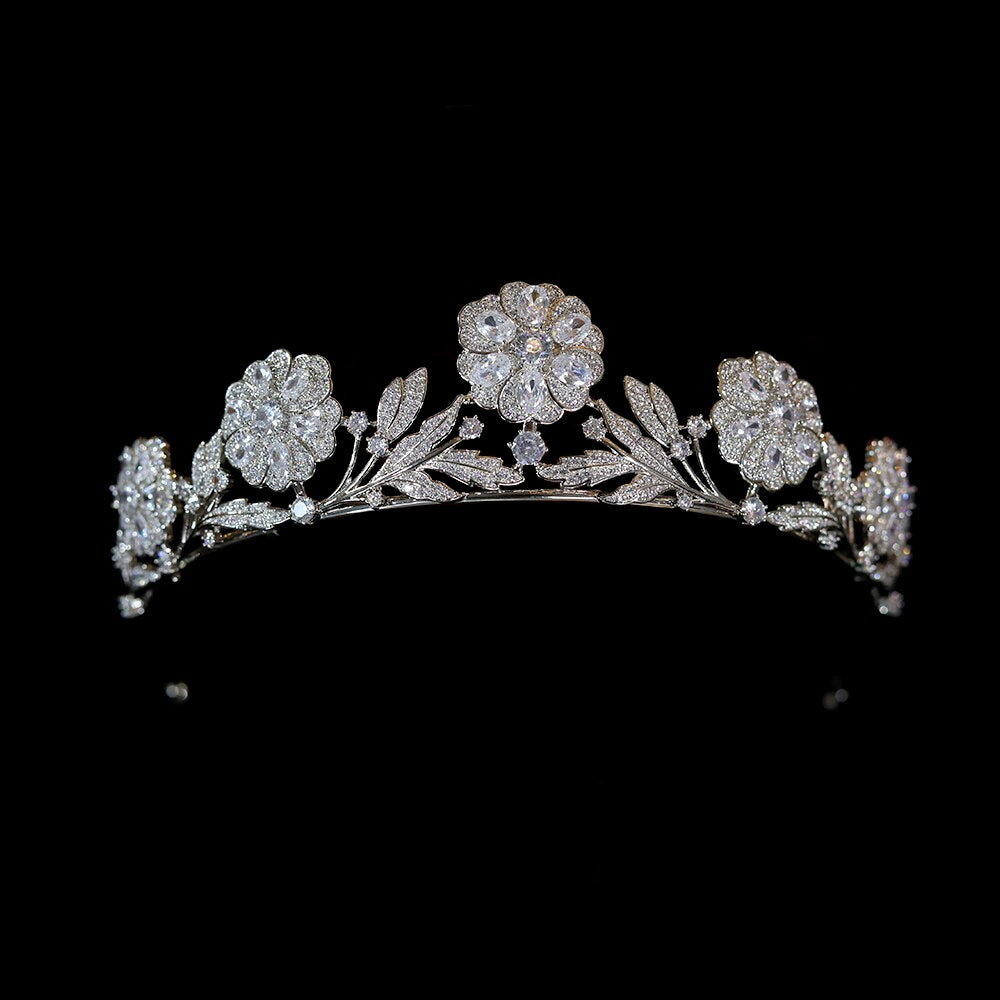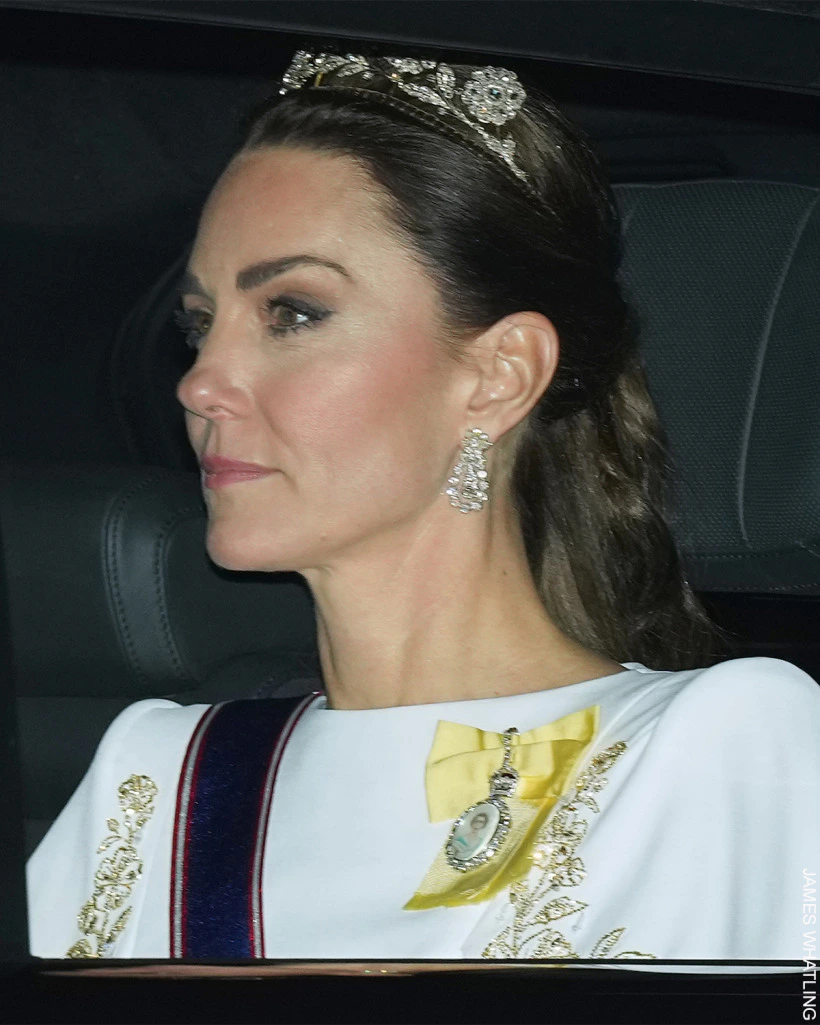UNPRECEDENTED IN ROYAL HISTORY: The Tiara That Broke the Code of Silence
Buckingham Palace, London. In the world of the British monarchy, diamonds are never merely decorative. They are signposts, diplomatic tools, and silent declarations of intent. Yet, on a night reserved for traditional royal elegance, Catherine, the Princess of Wales, delivered a statement so powerful and profound that it has been dubbed “Unprecedented in Royal History” by commentators. She chose to wear the Strathmore Rose Tiara, a glittering diamond piece that had not graced a royal head since the 1930s.
The moment she stepped into the State Ballroom, the silence was deafening. It wasn’t just the sparkle of the century-old diamonds under the crystal chandeliers; it was the sheer audacity of the choice. By selecting a forgotten, yet deeply significant heirloom, Catherine didn’t just wear a piece of jewelry—she donned a mantle of historical and, perhaps, political power, sending a clear, unspoken message about her role in the monarchy’s unfolding future.
READ MORE ![]()
Unspoken Defiance: Catherine’s 100-Year-Old Tiara, Camilla’s Rules, and the Silence That Defined the Monarchy’s Future
:max_bytes(150000):strip_icc():focal(749x0:751x2)/Kate-Middleton-Queen-Elizabeth-Tiara-112223-d28192389c9f4ec59cefce9a86039832.jpg)
UNPRECEDENTED IN ROYAL HISTORY: The Tiara That Broke the Code of Silence
Buckingham Palace, London. In the world of the British monarchy, diamonds are never merely decorative. They are signposts, diplomatic tools, and silent declarations of intent. Yet, on a night reserved for traditional royal elegance, Catherine, the Princess of Wales, delivered a statement so powerful and profound that it has been dubbed “Unprecedented in Royal History” by commentators. She chose to wear the Strathmore Rose Tiara, a glittering diamond piece that had not graced a royal head since the 1930s.
The moment she stepped into the State Ballroom, the silence was deafening. It wasn’t just the sparkle of the century-old diamonds under the crystal chandeliers; it was the sheer audacity of the choice. By selecting a forgotten, yet deeply significant heirloom, Catherine didn’t just wear a piece of jewelry—she donned a mantle of historical and, perhaps, political power, sending a clear, unspoken message about her role in the monarchy’s unfolding future.

The Ghost of the 1930s: Why the Strathmore Rose Tiara Matters
The Strathmore Rose Tiara is not among the main, frequently seen jewels like the Lover’s Knot or the Halo Tiara. Its debut by Catherine marks the first time it has been publicly worn in nearly a century. The tiara, gifted to Lady Elizabeth Bowes-Lyon (later The Queen Mother) by her father, the 14th Earl of Strathmore and Kinghorne, upon her marriage to the Duke of York (later King George VI) in 1923, carries immense symbolic weight.
It speaks of a foundational era: the beginning of a modern, beloved Queen Consort who guided the monarchy through the trauma of the abdication crisis and the destruction of World War II. For Catherine, the link to the Queen Mother—a figure synonymous with resilience, duty, and national steadfastness—is a deliberate and potent association.
The design itself, featuring delicate diamond roses that can be detached and worn as brooches, is an act of defiance in its simplicity and deep personal history. It is a jewel that belongs to the Windsor family story, specifically linked to the Queen Mother’s lineage before she ascended. By resurrecting it, Catherine evoked the rich, complex legacy of royal women who carved their own paths within the institution, including the poignant memory of her late mother-in-law, Princess Diana, who also mastered the art of non-verbal communication through fashion and jewelry.

The Gauntlet Thrown: A Response to Camilla’s ‘Crown Rotation’
The true explosive power of this moment lies in the unspoken context of the contemporary royal landscape. For months, whispers have circulated regarding Queen Camilla’s desire for a tighter control over the Crown Jewels and the extensive royal collection. Sources suggest an unofficial “crown rotation” policy has been implemented since the accession of King Charles III, prioritizing the established hierarchy and limiting the regular usage of certain primary pieces by non-monarchs, including the Princess of Wales.
This perceived attempt to assert a clear boundary—defining who has access to the most high-profile, recognizable jewels—made Catherine’s choice a bold, if entirely silent, counter-move.
Instead of accepting a rotation piece, or opting for a more modern tiara, Catherine went off-piste. She bypassed the entire established protocol by choosing an heirloom so rare it was effectively forgotten.
This was not an act of aggression, but an act of strategic independence. It communicated that the future Queen Consort does not need to wait for permission or inclusion into a new “rotation” to access history. She demonstrated that her status allows her to delve into the depths of the Royal Vault and bring forth a piece of history powerful enough to command attention and respect, regardless of any internal policies. Her action was a declaration that her legitimacy is drawn directly from the monarchy’s deepest historical roots, not from the current reign’s rules.
The King’s Emotion and the Unspoken Power Play
The reaction inside the ballroom confirmed the immense significance of the event. King Charles III, often reserved and focused on the official business of the evening, was reported to be visibly moved by his daughter-in-law’s entrance. His emotion was not just one of aesthetic appreciation; it was the recognition of a generational bridge.
Catherine, the consort to the future king, was not just paying homage to the past; she was securing her lineage within it.
The silence that fell upon the assembled dignitaries and royals was one of awe mixed with profound understanding. The Princess of Wales, dressed immaculately and crowned with this relic of the 1930s, projected an image of stability and continuity that is crucial for the monarchy in an era of transition. She cemented her role as the repository of the monarchy’s aspirational image—the elegance, the history, and the quiet strength—that the public so dearly seeks.
In that deafening silence, Catherine was asserting three key facts without uttering a word:
- She Owns the Narrative of Continuity: By wearing the Queen Mother’s initial married tiara, she directly links herself to the figure who successfully modernized the image of royalty, securing her place in the public consciousness as the legitimate successor to that legacy.
- She is Above the Rotation: Her ability to pluck a piece of such rarity from the vaults confirms her unique access and power, demonstrating that the only “rule” she follows is the one that serves the institution’s historical image.
- The Future Consort’s Role is Assured: The tiara underscored her unique position as the bedrock upon which the next reign will be built, a silent but absolute affirmation of her place beside Prince William.

The Message Sent Without a Single Word
What did this moment truly mean for the future of the royal family? It meant that the Princess of Wales is no longer merely following protocol; she is setting a precedent.
Catherine’s use of the Strathmore Rose Tiara was the equivalent of a power veto, delivered with impeccable style. It was a message to Queen Camilla, the King, the family, and the world: “I respect the hierarchy, but my connection to this institution is historical, profound, and non-negotiable.”
By choosing a piece that was literally mothballed for almost a century, Catherine ensured that she became the story, not just a participant in the event. She took a forgotten jewel and transformed it into a contemporary weapon of soft power, reminding everyone that the longest-lasting strength of the monarchy lies not in its current titles, but in its ability to selectively remember and embody its most beloved history. The silence in the ballroom was the sound of the future Queen Consort taking her ultimate, silent place.




